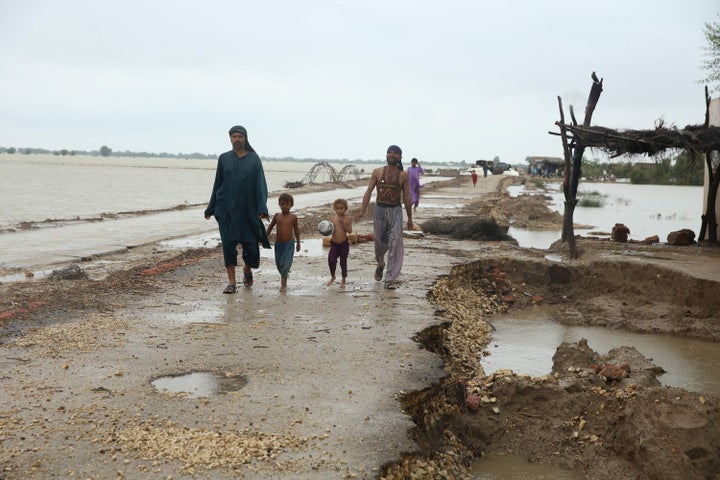Without even counting the raging wars, the soaring cost of living, and fresh outbreaks of contagious disease, this summer saw a cascade of disasters. Heat waves routinely broke temperature records and droughts on a previously unseen scale killed crops, halted cargo shipments, and idled power plants across multiple continents.
Now, in a brutal example of what scholars call “climate whiplash”, droughts are giving way to floods, throwing millions of lives into disarray from Kentucky to Karachi.
Months of unusually heavy monsoon rains and melting glaciers had, as of this week, deluged enormous swaths of Pakistan, leaving at least 1,000 dead, including hundreds of children, and sowing chaos in the country with the world’s sixth-largest nuclear arsenal.
“One-third of Pakistan is underwater – 33 million are affected. Please tell me how that is not catastrophic,” Sherry Rehman, Pakistan’s federal minister for climate change, said in a British TV interview Monday. “That is the size of a small country.”
Just over the border, in western China, flash floods last week killed more than a dozen and forced 100,000 to evacuate. In its center and east, meanwhile, the world’s No. 2 superpower was reeling from what weather historians call the worst heat wave ever recorded, which idled hydroelectric plants and sent a shockwave through the economy.

The extreme weather pendulum swing hammered Asia particularly hard. But Europe’s second-longest river, the Danube, ran so dry that dozens of sunken Nazi ships resurfaced. Cargo shipments stalled, throwing the continent’s trade into disarray. And the nuclear and coal power plants working overtime to make up for Europe’s shortage of Russian gas halted without enough water for cooling.
Just as swiftly, torrential rains across western Europe have caused new upheavals.
In the United States, the Kentucky River swelled and left Appalachian towns in ruin while the Colorado River ran low and forced water cuts on millions of Americans living across the west.
Disasters are part of a growing trend. As the world fails to adapt to rising global temperatures and new patterns of precipitation, the cost of water-related catastrophes is soaring.
Floods, droughts, and other water-related disasters could cost the world $5.6 trillion in gross domestic product between 2022 and 2050, a new study from the professional services firm GHD found.
Between 1970 and 2021, the total damages from all-natural disasters, not just those related to water, topped $3.64 trillion, according to World Meteorological Organization data crunched by Fortune, which first reported on the GHD research. Over the next 30 years, the U.S. alone could lose more than that – $3.7 trillion – just to disasters like floods and droughts, the study found.
Only a portion of these events can be definitively linked back to climate change, said Patrick Brown, an atmospheric scientist at the Breakthrough Institute, an environmental think tank.
“There’s no denying that climate change makes it so it can rain more and it rains more because there’s more greenhouse gas in the atmosphere,” he said. “But it can’t account for something like nine times as much as normal. Most of that is random variability in weather that you get no matter what.”
Attribution science, which dissects the meteorological and atmospheric details to determine how much global warming is to blame for various storms or heat waves, is a nascent field. And there are other variables, too. Shortages on the Colorado River stem in part from surging demand from a growing population in cities like Denver and Phoenix.
“There’s a cautious scientific perspective where you can look at the data and it’s clearly getting warmer and we’re seeing increased extreme events and economic costs, but you can’t tie any one event back to climate change in a scientifically rigorous way,” said Rich Sorkin, chief executive of Jupiter Intelligence, a climate risk-modeling consultancy with a staff of researchers. “There is also an awful lot of support for global warming being the driving event for the increased intensity and frequency of severe events and perspective from those who say the world is burning down and yesterday was too late to do anything about it.”
He pointed to a map the National Oceanic and Atmospheric Administration keeps on its website, showing average temperatures from 1884 to 2021. Set the map to 2004, and a dark red blob starts to appear over the Arctic. By this year, the blob had grown dramatically and started to encompass northern China.
The world has warmed by an average of 1.1 degrees Celsius above pre-industrial norms. But Sorkin said the map shows how misleading that average can be. In some regions, such as the Arctic, warming has been much higher.

“In 20 years, a meaningful chunk of the planet is now 4 degrees above average, and over the last few years the range where that’s occurring has shifted into the population and industrial heart of the planet,” Sorkin said. “This is a huge deal.”
August brought at least some cause for optimism. After more than a decade of failing to pass a national climate law, the U.S. enacted the Inflation Reduction Act, a sweeping federal package that included roughly $370 billion in climate and energy spending. The funding is roughly in line with what China and European Union member states have budgeted for similar infrastructure but could reverberate worldwide as laws in the planet’s most powerful country finally start to reflect the need to lower emissions.
But the legislation is just a start, and achieving its maximum emissions cuts would require a level of support on the state and local levels that few expect to materialize.
“At the moment, there is nothing the world is doing to change its trajectory in a material way,” Sorkin said. “Absent some major change in the policy environment, it’s just going to continue to get worse.”

